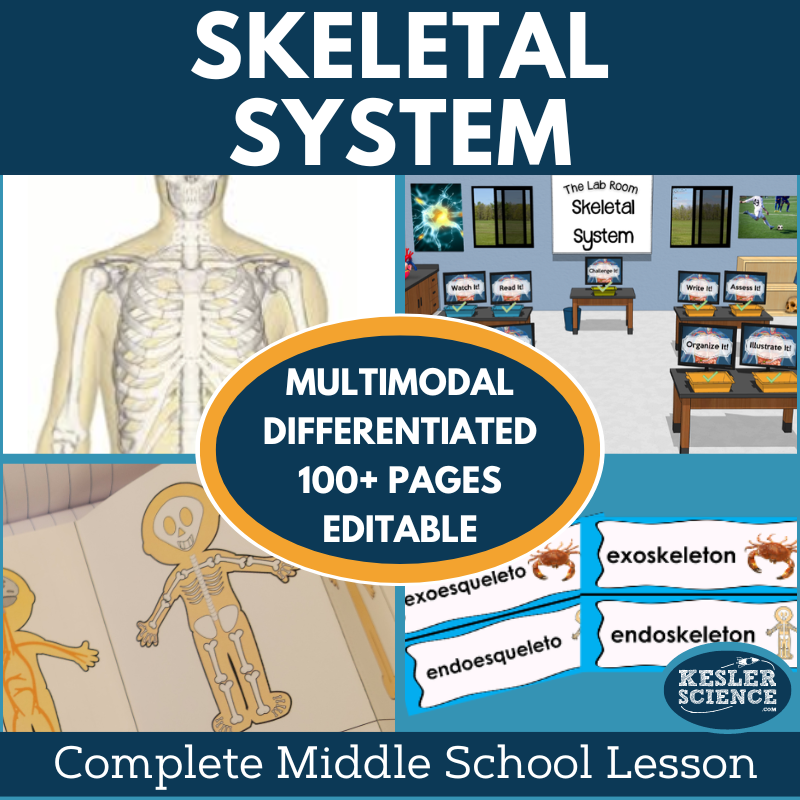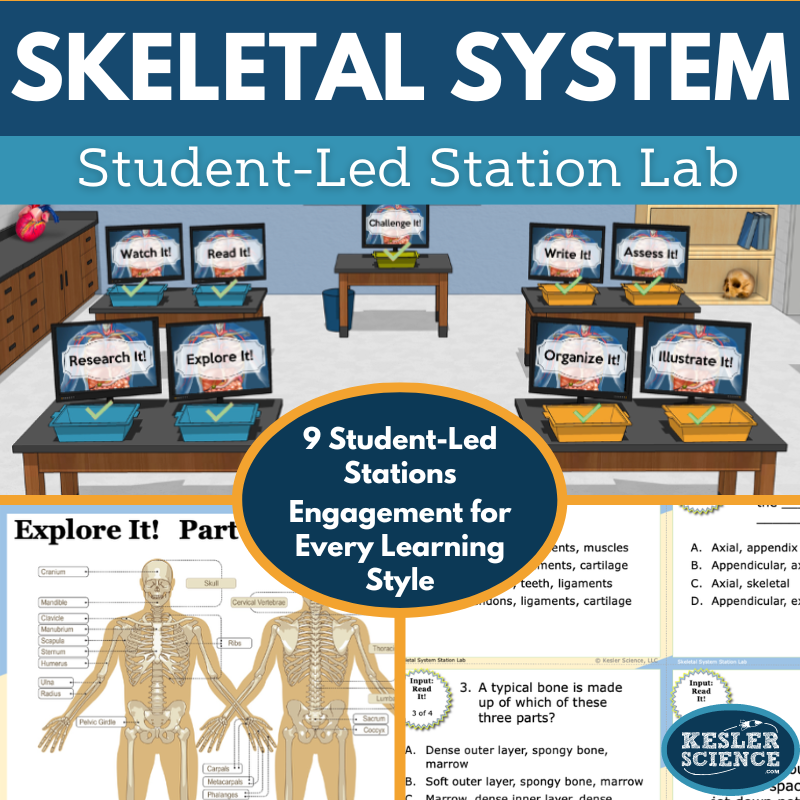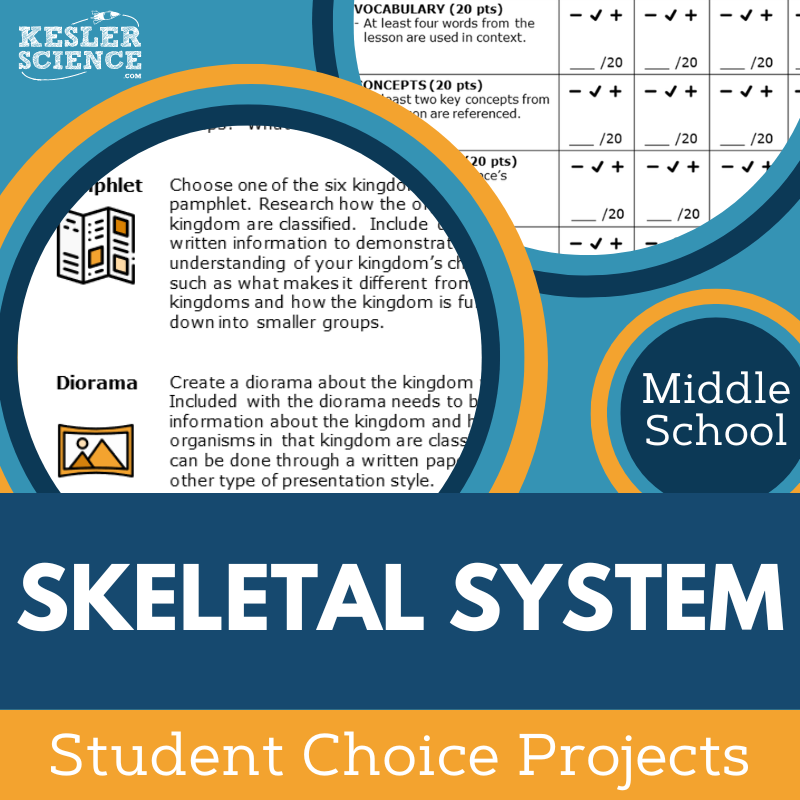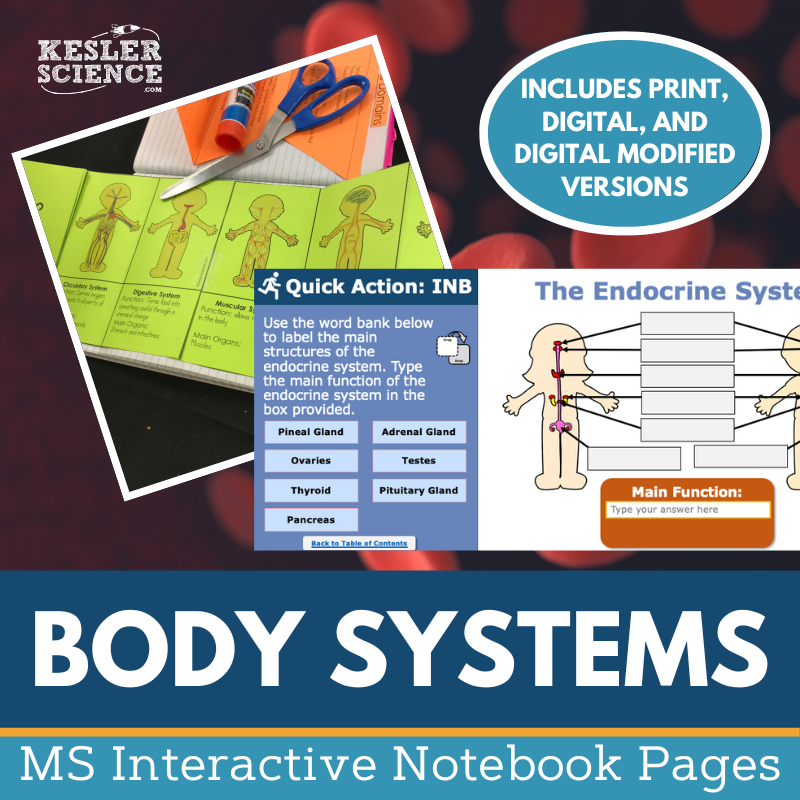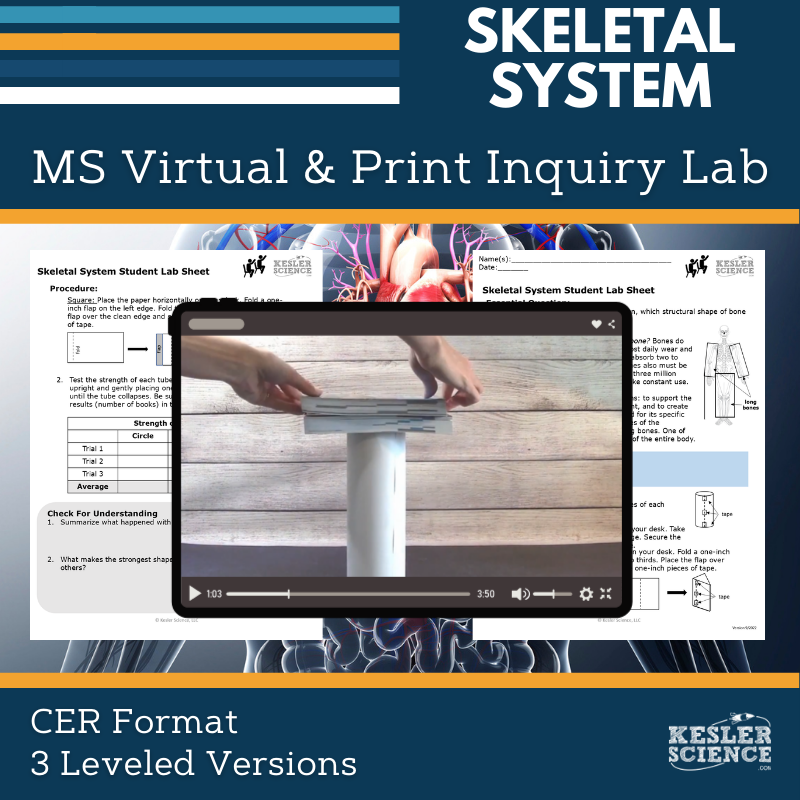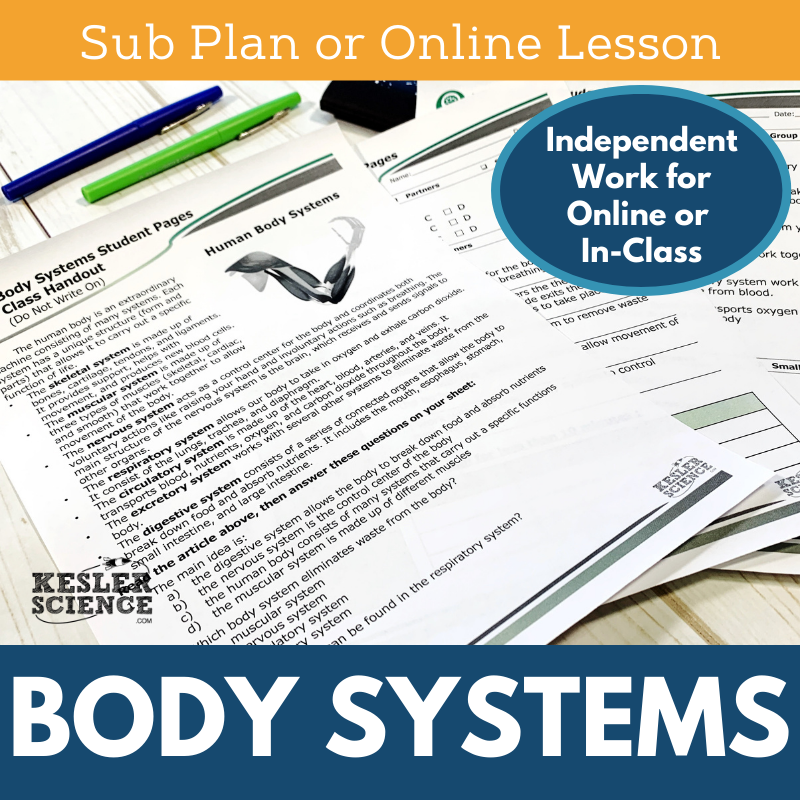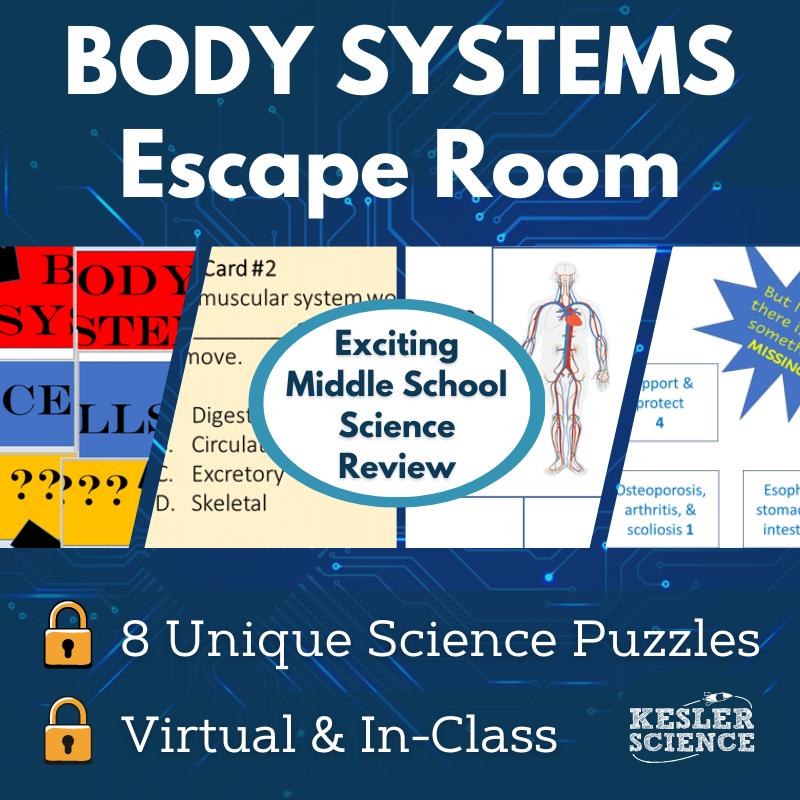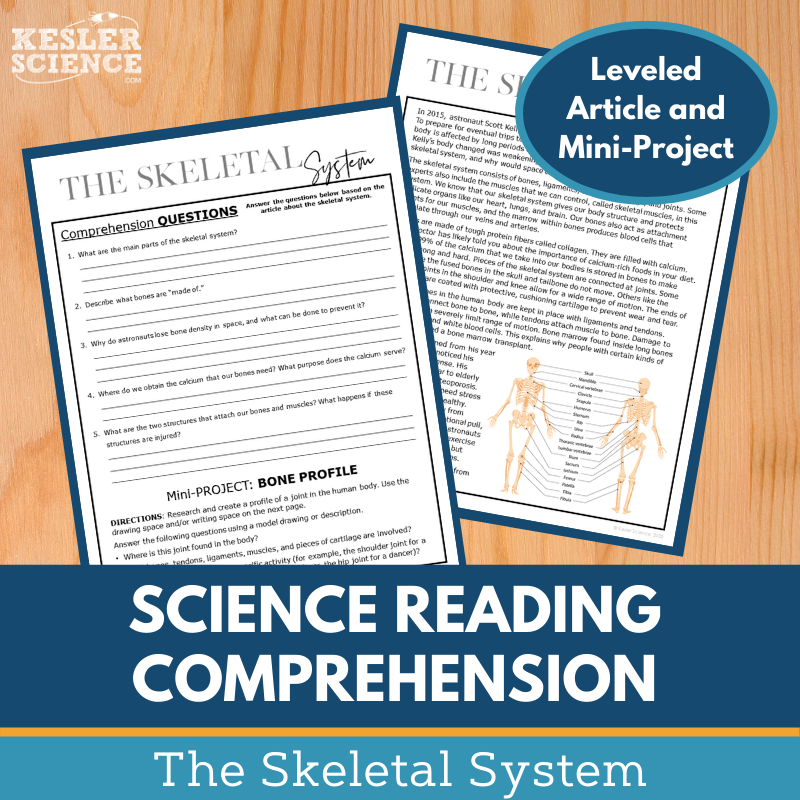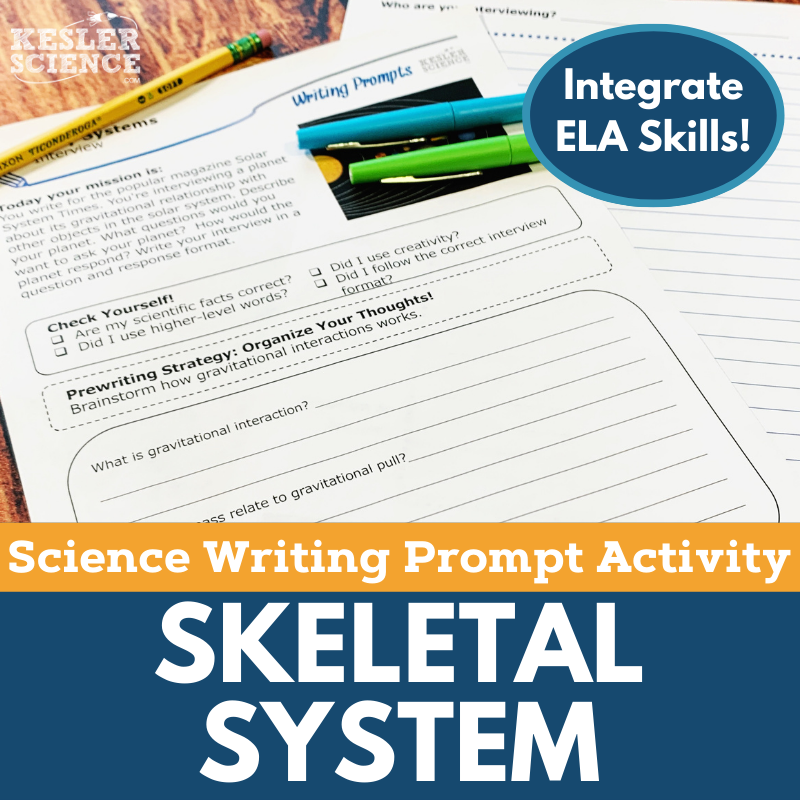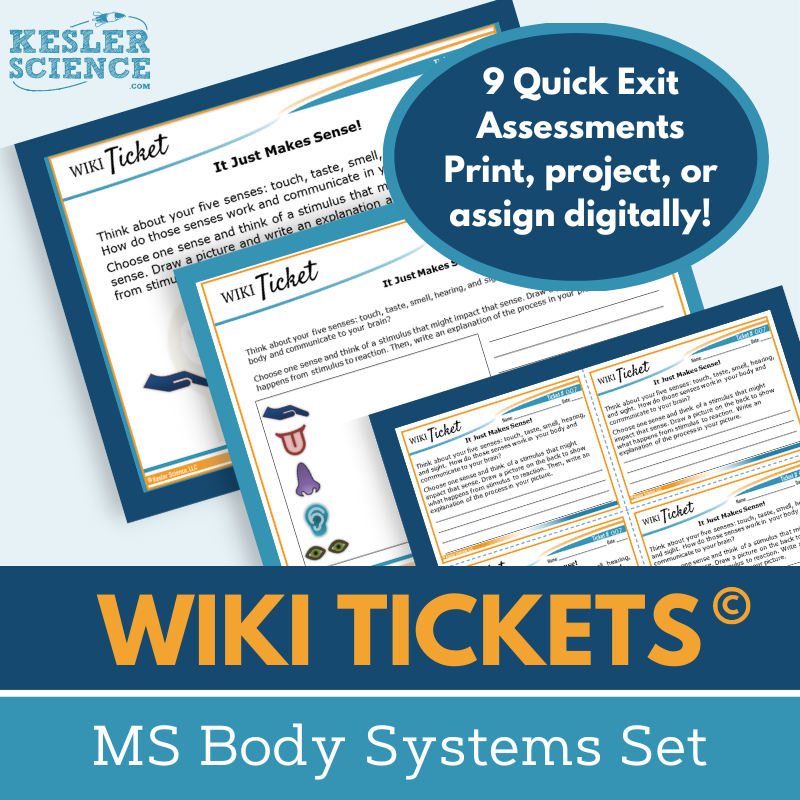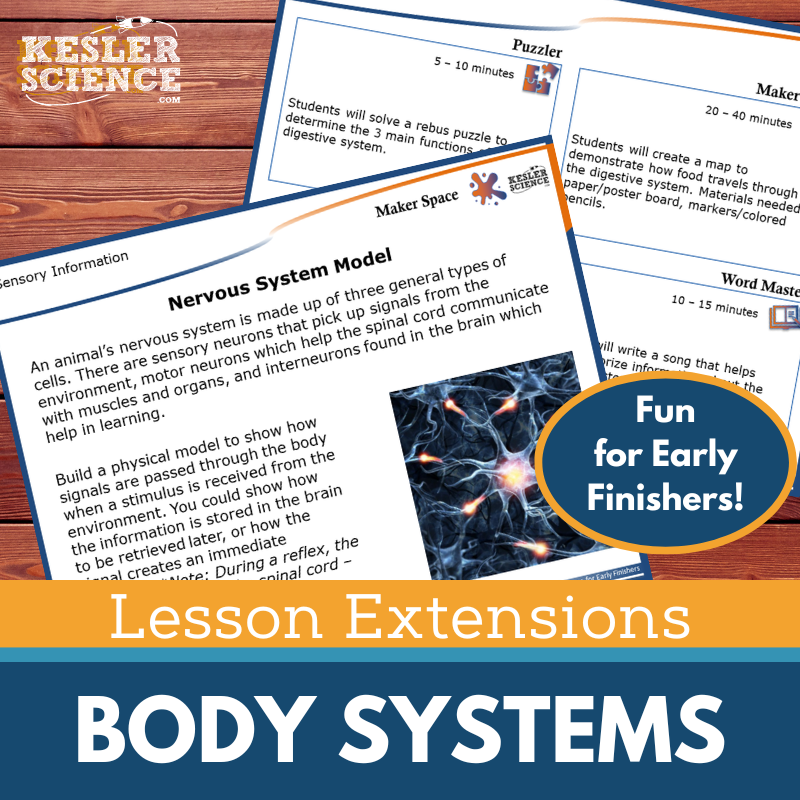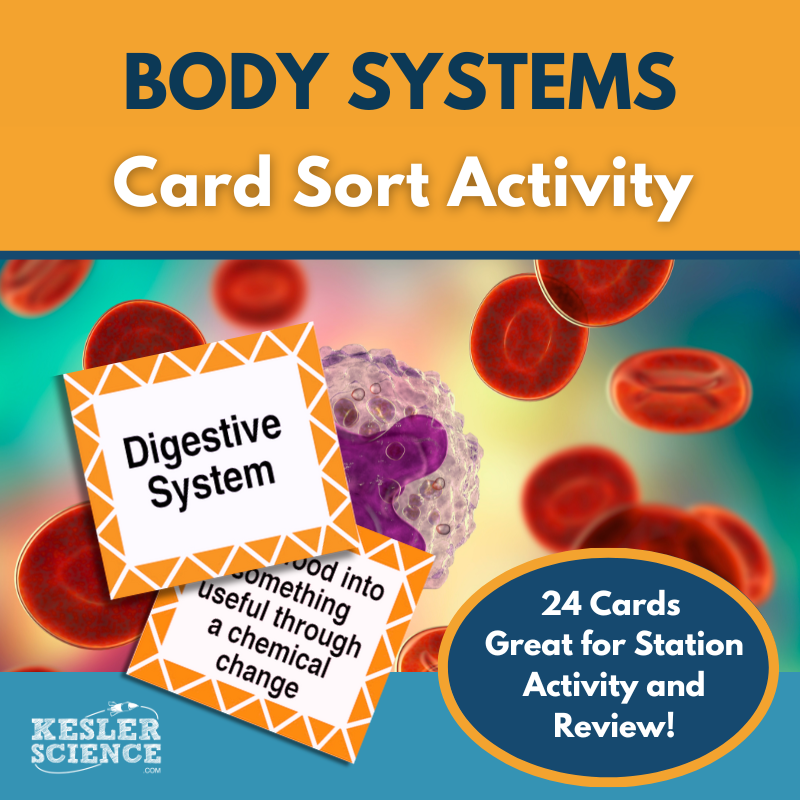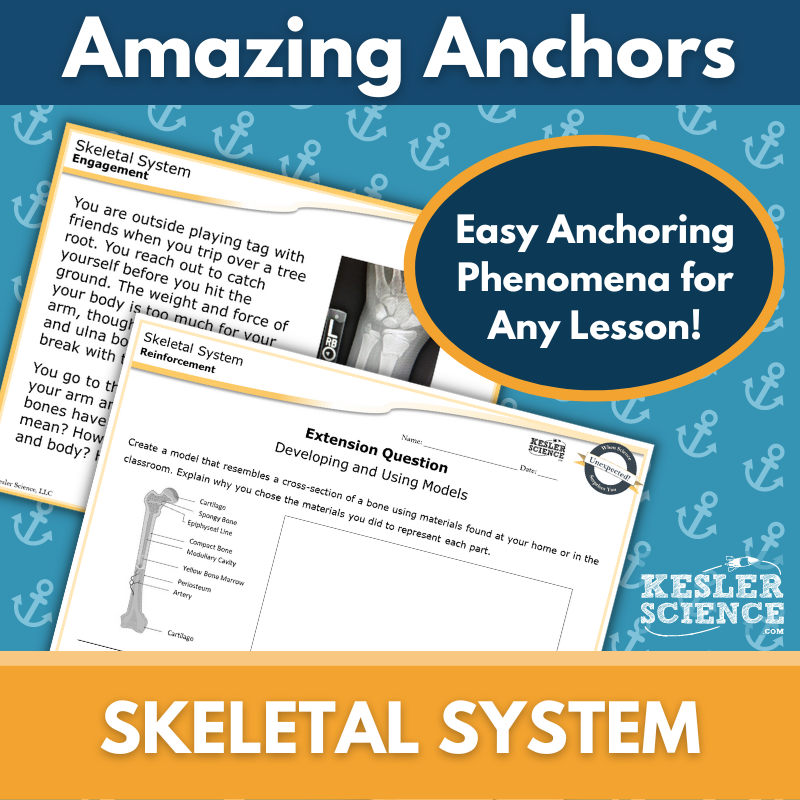Skeletal System Activities for Middle School Science
The Kesler Science Skeletal System Resources offer a dynamic, student-centered approach to teaching middle school students about the skeletal system. The resources below will give students a comprehensive understanding of skeletal system. All of the following materials are also included in the Kesler Science Membership.
The Kesler Science Skeletal System Complete 5E Lesson offers everything needed to teach a multi-day, student-led unit on the skeletal system for 6th-8th grade students. With minimal prep required, this resource encourages student engagement and success through differentiated, multimodal learning activities. The lesson is based on the 5E Model, covering Engagement, Exploration, Explanation, Elaboration, and Evaluation stages.
The student-led station lab includes nine stations, such as "Explore It!" and "Read It!", designed to help students absorb content through various learning styles. Output stations, like "Organize It!" and "Write It!", allow students to demonstrate understanding, and the bonus "Challenge It!" station offers extension activities for early finishers. Editable PowerPoints and interactive notebooks provide flexibility, and materials are available in English and Spanish.
This resource is fully adaptable for in-person or virtual classrooms, offering maximum flexibility with digital and printable formats. It includes assessment questions, student-choice projects, and review worksheets to reinforce learning, making it an ideal tool for diverse classroom settings.
The Kesler Science Skeletal System Complete 5E Lesson offers everything needed to teach a multi-day, student-led unit on the skeletal system for 6th-8th grade students. With minimal prep required, this resource encourages student engagement and success through differentiated, multimodal learning activities. The lesson is based on the 5E Model, covering Engagement, Exploration, Explanation, Elaboration, and Evaluation stages.
The student-led station lab includes nine stations, such as "Explore It!" and "Read It!", designed to help students absorb content through various learning styles. Output stations, like "Organize It!" and "Write It!", allow students to demonstrate understanding, and the bonus "Challenge It!" station offers extension activities for early finishers. Editable PowerPoints and interactive notebooks provide flexibility, and materials are available in English and Spanish.
This resource is fully adaptable for in-person or virtual classrooms, offering maximum flexibility with digital and printable formats. It includes assessment questions, student-choice projects, and review worksheets to reinforce learning, making it an ideal tool for diverse classroom settings.
The Kesler Science Skeletal System Station Lab is a modular, student-led activity that engages middle school students in exploring the skeletal system. With eight differentiated stations and a challenge station for early finishers, students direct their own learning, while the teacher facilitates. The materials are designed to save prep time and offer a personalized learning experience, perfect for both in-person and virtual settings.
The stations cover both input and output activities. Input stations, like "Explore It!" and "Research It!", allow students to interact with the material through hands-on demonstrations, reading passages, and videos. Output stations, such as "Organize It!" and "Write It!", give students opportunities to apply what they've learned by manipulating images, sketching models, and responding to prompts.
This resource is flexible and can be used in a variety of formats, with task cards and digital versions that adapt to both classroom and remote learning environments. It provides a hands-on, student-centered approach to understanding the skeletal system while saving teachers time.
The Kesler Science Skeletal System Station Lab is a modular, student-led activity that engages middle school students in exploring the skeletal system. With eight differentiated stations and a challenge station for early finishers, students direct their own learning, while the teacher facilitates. The materials are designed to save prep time and offer a personalized learning experience, perfect for both in-person and virtual settings.
The stations cover both input and output activities. Input stations, like "Explore It!" and "Research It!", allow students to interact with the material through hands-on demonstrations, reading passages, and videos. Output stations, such as "Organize It!" and "Write It!", give students opportunities to apply what they've learned by manipulating images, sketching models, and responding to prompts.
This resource is flexible and can be used in a variety of formats, with task cards and digital versions that adapt to both classroom and remote learning environments. It provides a hands-on, student-centered approach to understanding the skeletal system while saving teachers time.
The Kesler Science Skeletal System Student Choice Projects offer middle school students six project options plus a “design your own” project, allowing them to select a method that fits their learning style. A grading rubric is included, enabling assessment by teachers, peers, or self-evaluation. These projects are flexible, with editable rubrics that can be adjusted to meet specific grading needs, and they encourage students to demonstrate their understanding through creative, personalized work.
Differentiated for various learning needs, the project page has a modified version with three options tailored to assist students who need additional support. More advanced students can combine multiple projects for added challenge while using the same rubric. This ensures the lesson is adaptable for a wide range of learners.
The projects require basic classroom supplies, such as paper, markers, and scissors, with many options suitable for digital completion. Some students may use crafting supplies to build models, making this a versatile and accessible lesson for all students.
The Kesler Science Skeletal System Student Choice Projects offer middle school students six project options plus a “design your own” project, allowing them to select a method that fits their learning style. A grading rubric is included, enabling assessment by teachers, peers, or self-evaluation. These projects are flexible, with editable rubrics that can be adjusted to meet specific grading needs, and they encourage students to demonstrate their understanding through creative, personalized work.
Differentiated for various learning needs, the project page has a modified version with three options tailored to assist students who need additional support. More advanced students can combine multiple projects for added challenge while using the same rubric. This ensures the lesson is adaptable for a wide range of learners.
The projects require basic classroom supplies, such as paper, markers, and scissors, with many options suitable for digital completion. Some students may use crafting supplies to build models, making this a versatile and accessible lesson for all students.
The Kesler Science Body Systems Interactive Notebook Bundle provides a hands-on and engaging way for students to learn about body systems, offering both print and digital options for flexible use in traditional classrooms, 1:1 settings, or distance learning environments. Students can explore key systems, such as the circulatory, digestive, and nervous systems, while interacting with customized templates and reflection pages to enhance understanding.
The digital version features an interactive PowerPoint file that can be uploaded to Google Slides or other platforms like MS Teams or Canvas, making it easy to assign and complete remotely. Students can add notes, complete reflection activities, and access modified templates as needed. The teacher key and modified digital versions ensure accessibility for all learners.
The paper version includes blank and pre-filled templates, along with color photos for guidance, making it ideal for interactive notebooks. This comprehensive bundle offers everything teachers need to support students’ mastery of body system concepts while catering to diverse learning needs.
The Kesler Science Body Systems Interactive Notebook Bundle provides a hands-on and engaging way for students to learn about body systems, offering both print and digital options for flexible use in traditional classrooms, 1:1 settings, or distance learning environments. Students can explore key systems, such as the circulatory, digestive, and nervous systems, while interacting with customized templates and reflection pages to enhance understanding.
The digital version features an interactive PowerPoint file that can be uploaded to Google Slides or other platforms like MS Teams or Canvas, making it easy to assign and complete remotely. Students can add notes, complete reflection activities, and access modified templates as needed. The teacher key and modified digital versions ensure accessibility for all learners.
The paper version includes blank and pre-filled templates, along with color photos for guidance, making it ideal for interactive notebooks. This comprehensive bundle offers everything teachers need to support students’ mastery of body system concepts while catering to diverse learning needs.
The Kesler Science Skeletal System Inquiry Lab challenges students to investigate whether the cylindrical structure of long bones in the appendicular skeleton is the most supportive shape. Students will explore this question through either a hands-on, print-based experiment or an interactive virtual version that includes a full lab video demonstration. Both versions feature comprehension questions, Claim-Evidence-Reasoning (C.E.R.) prompts, and a final reflection to reinforce learning.
To support diverse learners, the lab comes in three differentiated levels: dependent, modified, and independent. Each version varies in the amount of guidance provided, making the lab accessible for students who need more structure as well as those ready for a more student-directed experience. The print lab requires minimal materials such as computer paper, tape, and textbooks, while the digital format includes everything students need within the file—no materials required.
Designed for maximum flexibility and engagement, this lab includes editable resources compatible with Google Slides and PowerPoint. Teachers also receive answer keys, teacher guides, and access to all three difficulty levels for both print and digital formats. Whether used in-person or online, this lab offers a multimodal, standards-aligned experience that helps students connect bone structure to strength through hands-on science.
The Kesler Science Skeletal System Inquiry Lab challenges students to investigate whether the cylindrical structure of long bones in the appendicular skeleton is the most supportive shape. Students will explore this question through either a hands-on, print-based experiment or an interactive virtual version that includes a full lab video demonstration. Both versions feature comprehension questions, Claim-Evidence-Reasoning (C.E.R.) prompts, and a final reflection to reinforce learning.
To support diverse learners, the lab comes in three differentiated levels: dependent, modified, and independent. Each version varies in the amount of guidance provided, making the lab accessible for students who need more structure as well as those ready for a more student-directed experience. The print lab requires minimal materials such as computer paper, tape, and textbooks, while the digital format includes everything students need within the file—no materials required.
Designed for maximum flexibility and engagement, this lab includes editable resources compatible with Google Slides and PowerPoint. Teachers also receive answer keys, teacher guides, and access to all three difficulty levels for both print and digital formats. Whether used in-person or online, this lab offers a multimodal, standards-aligned experience that helps students connect bone structure to strength through hands-on science.
The Kesler Science Body Systems Sub Plans guide students through an engaging sequence of activities, including a warm-up puzzle, a reading passage, and a hands-on project to create a booklet labeling the organs and functions of each body system. Using their booklets, students answer questions to deepen their understanding. Extension activities challenge early finishers to explore how systems like the skeletal and muscular systems work together or how multiple systems collaborate to digest a meal. The lesson concludes with an assessment or exit ticket.
Comprehensive support is provided for both in-class and distance learning formats, including substitute teacher instructions, a Google Form answer sheet, and editable resources. Each lesson is thoughtfully crafted to minimize downtime, with substitute directions, behavior checkpoints, and engaging activities to ensure a productive day. Digital versions allow students to annotate PDFs or submit answers online, making the resource versatile for remote or in-person use.
These middle school science sub plans are perfect for days when teachers are out, offering clear instructions for substitutes and meaningful, student-centered activities. They are also ideal for homework, extra credit, or small group sessions. Packed with editable documents, answer keys, and flexible learning formats, these plans make managing classroom learning seamless and stress-free.
The Kesler Science Body Systems Sub Plans guide students through an engaging sequence of activities, including a warm-up puzzle, a reading passage, and a hands-on project to create a booklet labeling the organs and functions of each body system. Using their booklets, students answer questions to deepen their understanding. Extension activities challenge early finishers to explore how systems like the skeletal and muscular systems work together or how multiple systems collaborate to digest a meal. The lesson concludes with an assessment or exit ticket.
Comprehensive support is provided for both in-class and distance learning formats, including substitute teacher instructions, a Google Form answer sheet, and editable resources. Each lesson is thoughtfully crafted to minimize downtime, with substitute directions, behavior checkpoints, and engaging activities to ensure a productive day. Digital versions allow students to annotate PDFs or submit answers online, making the resource versatile for remote or in-person use.
These middle school science sub plans are perfect for days when teachers are out, offering clear instructions for substitutes and meaningful, student-centered activities. They are also ideal for homework, extra credit, or small group sessions. Packed with editable documents, answer keys, and flexible learning formats, these plans make managing classroom learning seamless and stress-free.
The Kesler Science Body Systems Escape Room provides an immersive, hands-on way for students to demonstrate their understanding of major body systems, their structures, and their functions. With eight unique puzzles, teachers have full control over the activities, choosing which puzzles to use and their order—perfect for adapting to different class lengths. This engaging activity combines critical thinking, teamwork, and science content into a memorable classroom experience.
The escape room can be run using simple materials like manila envelopes or with more authentic props, including locks and a storage box, for a realistic feel. Both physical and digital versions are available, offering flexibility for in-person or virtual learning. Digital versions include editable PowerPoints and Google Slides, while printable materials support at-home or classroom setups. Tools like UV pens, red cellophane, and mirrors add to the fun, but alternatives are provided for cost-effective implementation.
The product includes everything needed for a smooth experience: teacher directions, a detailed answer key, a digital answer sheet, editable templates, a mood-setting video challenge, printable props, reward templates, and over 50 prize ideas. Whether used in a physical or digital format, the Kesler Science Escape Room is an engaging and versatile resource for reinforcing body systems knowledge.
The Kesler Science Body Systems Escape Room provides an immersive, hands-on way for students to demonstrate their understanding of major body systems, their structures, and their functions. With eight unique puzzles, teachers have full control over the activities, choosing which puzzles to use and their order—perfect for adapting to different class lengths. This engaging activity combines critical thinking, teamwork, and science content into a memorable classroom experience.
The escape room can be run using simple materials like manila envelopes or with more authentic props, including locks and a storage box, for a realistic feel. Both physical and digital versions are available, offering flexibility for in-person or virtual learning. Digital versions include editable PowerPoints and Google Slides, while printable materials support at-home or classroom setups. Tools like UV pens, red cellophane, and mirrors add to the fun, but alternatives are provided for cost-effective implementation.
The product includes everything needed for a smooth experience: teacher directions, a detailed answer key, a digital answer sheet, editable templates, a mood-setting video challenge, printable props, reward templates, and over 50 prize ideas. Whether used in a physical or digital format, the Kesler Science Escape Room is an engaging and versatile resource for reinforcing body systems knowledge.
The Kesler Science Skeletal System Reading Comprehension Lesson provides middle school students with a nonfiction article detailing the main structures and functions of the skeletal system. Students engage with the article, answer comprehension questions, and research a joint profile, enhancing both science literacy and reading comprehension. The leveled passage, with Lexile levels of 1100-1300, offers differentiated reading opportunities for a wide range of learners.
Included in the lesson are 5-7 comprehension questions, a mini-project, and a Cornell notes template. The resource features colorful graphics, and it can be printed in grayscale for easy use. Teachers can integrate the lesson into in-person or virtual classrooms, as it’s compatible with platforms like Google Classroom and MS Teams, allowing for flexible learning environments.
This resource is ideal for various classroom settings, including for absent students, sub plans, or extra credit. The article encourages classroom discussions and supports the development of students' reading comprehension and science literacy. It’s a versatile tool that teachers can incorporate throughout a unit or as part of a broader strategy to build science knowledge.
The Kesler Science Skeletal System Reading Comprehension Lesson provides middle school students with a nonfiction article detailing the main structures and functions of the skeletal system. Students engage with the article, answer comprehension questions, and research a joint profile, enhancing both science literacy and reading comprehension. The leveled passage, with Lexile levels of 1100-1300, offers differentiated reading opportunities for a wide range of learners.
Included in the lesson are 5-7 comprehension questions, a mini-project, and a Cornell notes template. The resource features colorful graphics, and it can be printed in grayscale for easy use. Teachers can integrate the lesson into in-person or virtual classrooms, as it’s compatible with platforms like Google Classroom and MS Teams, allowing for flexible learning environments.
This resource is ideal for various classroom settings, including for absent students, sub plans, or extra credit. The article encourages classroom discussions and supports the development of students' reading comprehension and science literacy. It’s a versatile tool that teachers can incorporate throughout a unit or as part of a broader strategy to build science knowledge.
The Kesler Science Skeletal System Writing Prompt Activity engages middle school students with a fun, creative way to explore life science. Using a "Day in the Life" story format, students can apply their understanding of the skeletal system while improving their writing. This activity is designed for easy integration into your curriculum, whether for elaboration, review, or assessment purposes.
The resource includes teacher directions, answer guides, rubrics, and a variety of formats to suit different classroom settings. Printable options are available in full and half-sized handouts, while the digital version works seamlessly for virtual learners using PowerPoint or Google Slides. This makes it ideal for in-person and remote classrooms alike.
With its adaptability, the activity can be used in various ways, such as a pre-test formative assessment, student choice project, or extra credit task. It also works as a differentiation exercise and is perfect for TELPAS samples or make-up work, offering students a chance to deepen their knowledge and demonstrate their understanding of the skeletal system.
The Kesler Science Skeletal System Writing Prompt Activity engages middle school students with a fun, creative way to explore life science. Using a "Day in the Life" story format, students can apply their understanding of the skeletal system while improving their writing. This activity is designed for easy integration into your curriculum, whether for elaboration, review, or assessment purposes.
The resource includes teacher directions, answer guides, rubrics, and a variety of formats to suit different classroom settings. Printable options are available in full and half-sized handouts, while the digital version works seamlessly for virtual learners using PowerPoint or Google Slides. This makes it ideal for in-person and remote classrooms alike.
With its adaptability, the activity can be used in various ways, such as a pre-test formative assessment, student choice project, or extra credit task. It also works as a differentiation exercise and is perfect for TELPAS samples or make-up work, offering students a chance to deepen their knowledge and demonstrate their understanding of the skeletal system.
The Kesler Science WIKI Tickets provide engaging, flexible formative assessments for 6th–8th grade science topics, designed to check student understanding in a fun and interactive way. Aligned with NGSS and TEKS standards, these assessments cover nine body systems, including the circulatory, digestive, endocrine, excretory, muscular, nervous, respiratory, and skeletal systems, as well as sensory information. Each topic includes five formats: projection, full-page, split-page, quarter-page handouts, and editable digital versions for use in PowerPoint or Google Slides.
These colorful WIKI Tickets can be used as exit tickets, bellringers, or quick checks for learning progress. Teachers have the flexibility to use them in print, project them for whole-class responses, or assign them digitally for 1:1 and virtual settings. A bonus table of contents file shows the alignment of each ticket to middle school science standards, ensuring comprehensive coverage of key concepts.
Perfect for both in-person and remote learning, the WIKI Tickets make lesson planning easier while keeping students engaged and on track. These versatile tools ensure you're prepared to assess understanding in any learning environment.
The Kesler Science WIKI Tickets provide engaging, flexible formative assessments for 6th–8th grade science topics, designed to check student understanding in a fun and interactive way. Aligned with NGSS and TEKS standards, these assessments cover nine body systems, including the circulatory, digestive, endocrine, excretory, muscular, nervous, respiratory, and skeletal systems, as well as sensory information. Each topic includes five formats: projection, full-page, split-page, quarter-page handouts, and editable digital versions for use in PowerPoint or Google Slides.
These colorful WIKI Tickets can be used as exit tickets, bellringers, or quick checks for learning progress. Teachers have the flexibility to use them in print, project them for whole-class responses, or assign them digitally for 1:1 and virtual settings. A bonus table of contents file shows the alignment of each ticket to middle school science standards, ensuring comprehensive coverage of key concepts.
Perfect for both in-person and remote learning, the WIKI Tickets make lesson planning easier while keeping students engaged and on track. These versatile tools ensure you're prepared to assess understanding in any learning environment.
The Kesler Science Body Systems Lesson Extensions provide student-choice activities designed to challenge early finishers and deepen their understanding of body systems through engaging, creative, and rigorous learning opportunities. These activities are perfect for ending lessons, filling testing gaps, or keeping students focused with NGSS- and TEKS-aligned content. Students can explore critical thinking and creativity through puzzles, STEAM-based maker activities, digital media projects, and creative writing tasks.
Each extension includes teacher directions, answer keys, projection options for digital boards, and printable handouts in full- and half-sheet formats. Topics covered include the circulatory, digestive, endocrine, excretory, integumentary, muscular, nervous, respiratory, and skeletal systems, as well as sensory information, making them a perfect supplement for anatomy and physiology units.
Kesler Science Lesson Extensions help scaffold learning for independent learners, offering a variety of high-level activities to enhance problem-solving, creativity, and hands-on engagement, all while maintaining alignment with key science standards.
The Kesler Science Body Systems Lesson Extensions provide student-choice activities designed to challenge early finishers and deepen their understanding of body systems through engaging, creative, and rigorous learning opportunities. These activities are perfect for ending lessons, filling testing gaps, or keeping students focused with NGSS- and TEKS-aligned content. Students can explore critical thinking and creativity through puzzles, STEAM-based maker activities, digital media projects, and creative writing tasks.
Each extension includes teacher directions, answer keys, projection options for digital boards, and printable handouts in full- and half-sheet formats. Topics covered include the circulatory, digestive, endocrine, excretory, integumentary, muscular, nervous, respiratory, and skeletal systems, as well as sensory information, making them a perfect supplement for anatomy and physiology units.
Kesler Science Lesson Extensions help scaffold learning for independent learners, offering a variety of high-level activities to enhance problem-solving, creativity, and hands-on engagement, all while maintaining alignment with key science standards.
The Body Systems Card Sort activity helps students learn about the ten major human body systems by sorting them based on their system name, main function, and major organs. This engaging activity can be used during instruction, as a review game, or for intervention and tutoring, providing a fun alternative to traditional study methods.
The body systems included are circulatory, skeletal, endocrine, muscular, integumentary, nervous, digestive, excretory, respiratory, and reproductive. This resource is suitable for any middle school students studying body systems.
The Body Systems Card Sort activity helps students learn about the ten major human body systems by sorting them based on their system name, main function, and major organs. This engaging activity can be used during instruction, as a review game, or for intervention and tutoring, providing a fun alternative to traditional study methods.
The body systems included are circulatory, skeletal, endocrine, muscular, integumentary, nervous, digestive, excretory, respiratory, and reproductive. This resource is suitable for any middle school students studying body systems.
This Amazing Anchors Phenomenon Lesson introduces and reinforces the skeletal system through a real-world scenario involving broken bones. It begins with an engaging introductory reading that explores why bones break and how the body responds. Comprehension and extension questions guide students toward deeper understanding and prepare them for further instruction. A follow-up explanatory reading explains the science of the skeletal system in a student-friendly way and includes additional comprehension and reinforcement questions.
Designed to complement any lesson on the skeletal system, this no-prep resource includes teacher directions with answer keys, editable materials, and multiple formats. It comes in print (full- and half-sheet handouts) and digital versions (editable PowerPoints for Google Classroom and other LMS platforms), with full-page slides for projection. The materials are tailored to support use in both in-person and virtual classrooms.
Differentiation is built in with a modified version that includes language supports and sentence starters to help students succeed with comprehension questions. These two readings serve as effective bookends to your main lesson and work well within the Engagement and Elaborate phases of the 5E model, helping students make meaningful connections between real-world phenomena and science content.
This Amazing Anchors Phenomenon Lesson introduces and reinforces the skeletal system through a real-world scenario involving broken bones. It begins with an engaging introductory reading that explores why bones break and how the body responds. Comprehension and extension questions guide students toward deeper understanding and prepare them for further instruction. A follow-up explanatory reading explains the science of the skeletal system in a student-friendly way and includes additional comprehension and reinforcement questions.
Designed to complement any lesson on the skeletal system, this no-prep resource includes teacher directions with answer keys, editable materials, and multiple formats. It comes in print (full- and half-sheet handouts) and digital versions (editable PowerPoints for Google Classroom and other LMS platforms), with full-page slides for projection. The materials are tailored to support use in both in-person and virtual classrooms.
Differentiation is built in with a modified version that includes language supports and sentence starters to help students succeed with comprehension questions. These two readings serve as effective bookends to your main lesson and work well within the Engagement and Elaborate phases of the 5E model, helping students make meaningful connections between real-world phenomena and science content.
Year-Round Resources
These year-round activities will increase your students' understanding of many middle school science topics. All of these activities are also included in the Kesler Science Membership.
Visual Data & Graphing
You're not alone if your students struggle with understanding graphs, charts, and tables. It's a skill that takes an enormous amount of practice. This resource will help students build a strong foundation in analyzing data and creating their own data visualizations.
Bell Ringers and Warm-Ups
These middle school science bell ringers are an excellent way to engage your students as soon as they walk into your classroom. This comprehensive FULL YEAR resource includes everything you need to start off each science class with an interesting warm-up activity.
Review Board Games
Each game board has been carefully designed to keep students engaged. There are 10 different action spaces on each board and dozens of question cards. All of the actions are related to science concepts and keep the students motivated throughout the game.
Each game is ready to play. Simply print out the board and the cards and let the students enjoy reviewing nine different units.
Essential Questions
Below are the essential questions associated with the lessons and activities included in this unit. This topic is only one of more than 100 middle school science topics included in the Kesler Science Membership.
-
What is the main function of the skeletal system and how is it structured?
-
What are the main organs associated with this system?
Kesler Science Membership
Imagine never having to search for another middle school science lesson again. The membership gives you access to ALL of the Kesler Science products in one place (Yes, including everything above).
Say goodbye to long hours of lesson prep.

